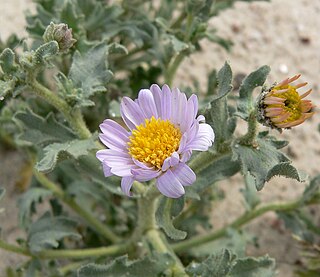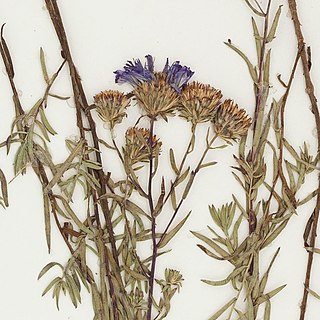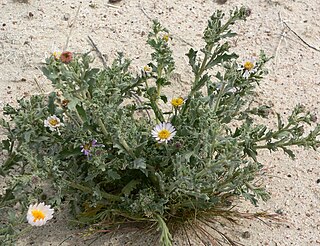
Verbena, also known as vervain or verveine, is a genus in the family Verbenaceae. It contains about 150 species of annual and perennial herbaceous or semi-woody flowering plants. The majority of the species are native to the Americas and Asia; however, Verbena officinalis, the common vervain or common verbena, is the type species and native to Europe.

Astereae is a tribe of plants in the family Asteraceae that includes annuals, biennials, perennials, subshrubs, shrubs, and trees. They are found primarily in temperate regions of the world. Plants within the tribe are present nearly worldwide divided into over 250 genera and more than 3,100 species, making it the second-largest tribe in the family behind Senecioneae.

Isocoma, commonly called jimmyweed or goldenweed, is a genus of North American semi-woody shrubs in the family Asteraceae. It is found in the semi-arid areas of Southwestern United States and Mexico.

Ericameria nauseosa, commonly known as chamisa, rubber rabbitbrush, and gray rabbitbrush, is a shrub in the sunflower family (Aster) found in the arid regions of western North America.

Pseudognaphalium is a genus of flowering plants in the sunflower family. Members of the genus are commonly known as cudweeds or rabbit tobacco. They are widespread in tropical and temperate regions of many countries.

Arida is a genus of flowering plants in the daisy family, Asteraceae.

Xanthisma, common name sleepy-daisy, is a genus of flowering plants in the family Asteraceae.
Osbertia is a genus of Mesoamerican flowering plants in the family Asteraceae.

Archibaccharis is a genus of flowering plants in the family Asteraceae.
Guy L. Nesom is an American writer and botanist.
Aztecaster is a genus of Mexican flowering plants in the family Asteraceae.
Tomentaurum is a genus of Mexican plants in the family Asteraceae. Its species are native to northern Mexico.
Tomentaurum niveum is a species of flowering plant in the family Asteraceae, native to the states of Sonora and Chihuahua in northern Mexico. It was first described by Sereno Watson in 1888 as Haplopappus niveus.

Erythranthe, the monkey-flowers and musk-flowers, is a diverse plant genus with more than 120 members in the family Phrymaceae. Erythranthe was originally described as a separate genus, then generally regarded as a section within the genus Mimulus, and recently returned to generic rank. Mimulus sect. Diplacus was segregated from Mimulus as a separate genus at the same time. Mimulus remains as a small genus of eastern North America and the Southern Hemisphere. Molecular data show Erythranthe and Diplacus to be distinct evolutionary lines that are distinct from Mimulus as strictly defined, although this nomenclature is controversial.

Diplacus is a plant genus in the family Phrymaceae, which was traditionally placed in family Scrophulariaceae. In the 2012 restructuring of Mimulus by Barker, et al., based largely upon DNA evidence, seven species were left in Mimulus, 111 placed into Erythranthe, 46 placed into Diplacus, two placed in Uvedalia, and one each placed in Elacholoma, Mimetanthe, and Thyridia. Diplacus used to be a separate genus from Mimulus, but it was merged into Mimulus no later than 1905, until the 2012 restructuring. Dry and rocky areas are preferred.

Sanrobertia is a genus of flowering plants within the subtribe Symphyotrichinae of the family Asteraceae. It is monotypic, meaning there is only one species within the genus. Sanrobertia gypsophila is a rare endemic known only from Nuevo León, Mexico.

Symphyotrichum turneri is a species of flowering plant in the family Asteraceae native to Durango, Mexico.

Leucosyris is a genus of flowering plants belonging to the family Asteraceae.












